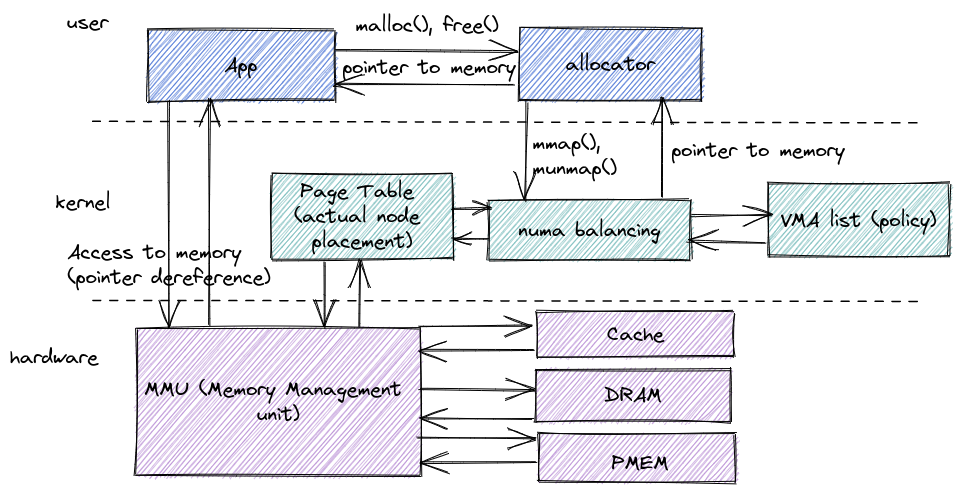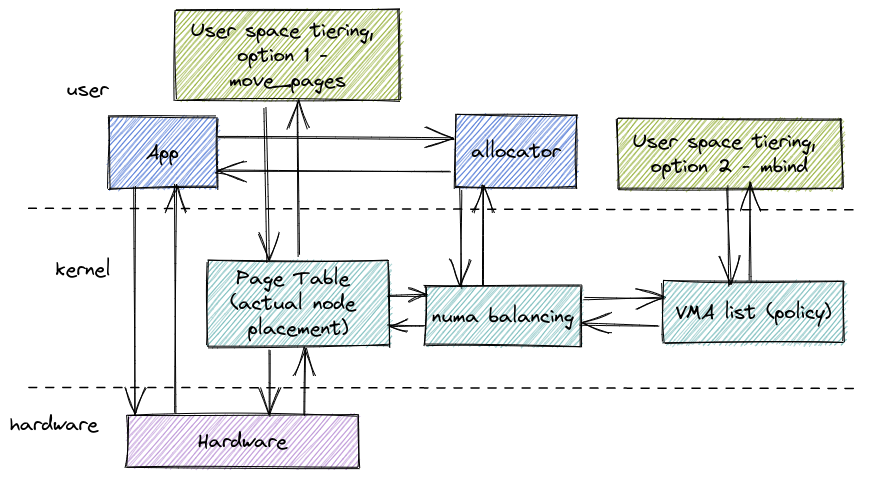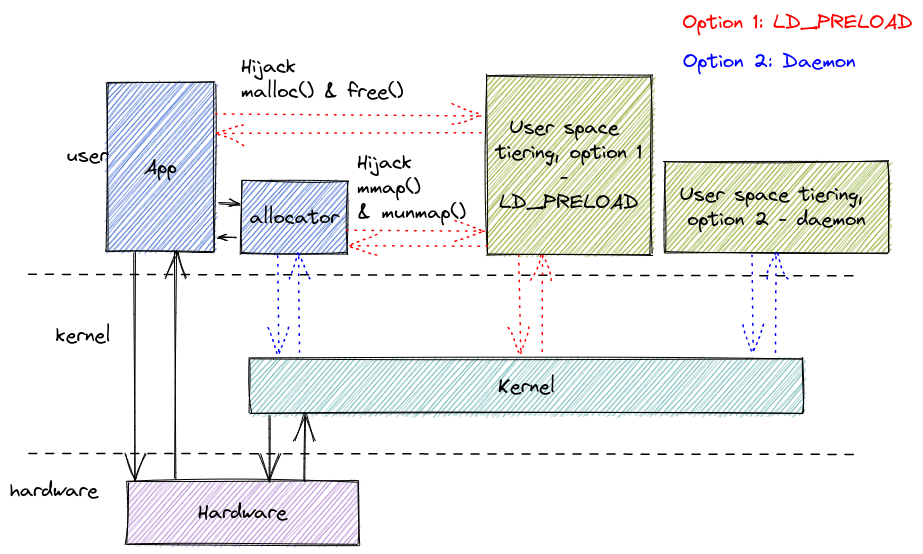Memory Tiering (part 2): Writing Transparent Tiering Solution
This is the second part of the series of articles about memory tiering. The first one explained what memory tiering is and why we need it, the second one will explain some mechanisms behind transparent tiering.
This article is intended for those who would like to learn how tiering/numa balancing or memory profiling solutions work under the hood. We will focus on a high-level overview of how tiering/numa balancing could be designed, instead of dissecting any particular solution. This approach means that the readers can also learn some general knowledge on topics such as Linux API, hardware-accelerated performance monitoring or architecture of Linux apps.
Key components
Before we delve into details, we will shortly discuss key requirements and map them to components of the software we want to design. The basis of a tiering system consists either of making a decision about the target tier in allocation time or of monitoring which pages to move and moving them.
A user might want to use features such as:
- per-application configuration,
- configuration of how aggressively balancing should be performed,
- auto-configuration, auto profiling and tuning of an application,
It might be important for them:
- not to recompile kernel or introduce new kernel modules,
- to have a portable solution - not hardware or kernel-specific.
In order to satisfy those requirements, the basic functionalities must be implemented:
- handling configuration,
- monitoring hotness or other metrics,
- decision-making,
- action: page movement or intelligent data placement.
All of them can be implemented either in user space, using libnuma, or directly in kernel. We will explore some of the possible design decisions and how they affect the aforementioned functionalities.
Options - user space vs kernel space
One of the first decisions to make is to choose whether the solution should be located in user space or in kernel space. Kernel space might seem to be the obvious answer, as there are multiple reasons to do this, among others:
- access to MMU and PAGE_FAULT handling:
- this is how automatic NUMA balancing (kernel) checks accesses,
- reduced context switch overhead:
- certain operations can only be done from kernel space,
- calling syscalls in a loop is not that efficient,
- better integration with default kernel balancing possible,
- availability of data structures from kernel, lower overhead:
- no need to duplicate data between user space and kernel space in order to track the state of pages.
On the other hand, user space has the following strong points:
- safety: a bug in user space will not shut the whole machine down or destroy data of other processes,
- ease and speed of experimentation: no need to compile custom kernel or reboot the machine; a separate kernel module is not that easy to experiment with neither,
- portability: a user space solution should work with many different production systems, typically those that meet the minimum up-to-date criteria,
- access to allocations - lower granularity than OS, which can only move pages.
The last point might need some clarification - individual allocations cannot
be moved between tiers, only pages can; however, individual allocations
are done in user space, with only occasional mmap() being handled
by the OS when the user space library (i.e. glibc, jemalloc, tcmalloc, mimalloc
or any other allocator) runs out of memory. It means that kernel only knows
about mappings; in the user space, individual calls to malloc()
and free() can be hijacked and used for data placement, tier prediction
or grouping similar data on the same pages, so that it works better
with transparent data movement.
As the reader might see, the answer to where to implement the solution is not obvious. There are solutions available and already deployed on production systems that handle balancing in kernel, and in user space.
There is also another question - can user and kernel space solutions work
together? There are plenty of opportunities for that, e.g., objects of similar
hotness might be placed on the same pages in user space, so that kernal can
efficiently move data between different tiers. The placement can be done
either at allocation time or at runtime, by merging partially-empty pages.
There is always a question of cost and of possible performance gain -
performing any logic in malloc() can impact performance a lot, but so
can misallocating the data to unsuitable tier.
Handling configuration
It might seem to be a trivial thing to do, but the mechanism of configuring the application also requires some thought. In user space, a text config file or arguments passed via command line might be enough. A kernel solution would require a more complicated config handling, either via additional system calls or by a special file, e.g., writing to which would trigger re-configuration of tiering.
A user space solution (or a user space component that handles communication with kernel) might even contain a full-scale TCP or CLI client, with an easy-to-configure graphical user interface. In this case, only imagination is the limit. And time. And human resources.
Tracking hotness
There are multiple ways of tracking hotness of pages, but some of them are easier to deal with in kernel space. A good example is the hotness tracking mechanism from the Linux kernel, which works by periodically unmapping pages and handling hint page faults. Even though such handling might be possible in user space, it comes with a great deal of issues ranging from additional overhead and low performance to possible data races. It is noteworthy that this solution lets the developer check on which CPU the process was executed and migrate the data between CPU sockets instead of just between DRAM and PMEM or CXL - this is the basis of kernel numa balancing.
Another way to monitor page accesses is via hardware mechanisms originally destined for profiling applications, such as Intel PEBS. It is worth noting that, in this case, the information about accesses comes with some delay - first, an access occurs, then it’s stored in a buffer and, after some time, the event is processed by the user. PEBS also exposes info about the core the process was executed on. These features, however, are hardware specific and might not be available on all platforms or might not be supported by virtual machines.
Linux kernel provides an API that can be used to track hotness as well. The
files to check are /sys/kernel/mm/page_idle/bitmap
and /proc/kpageflags. Both, the
former
and the
latter
work by setting pages status to IDLE and checking when the status changes.
The good thing about it is that it’s hardware-agnostic, but might come with
various performance. Also, not every kernel has support for this API enabled.
Finally, kernel 5.15 added support for DAMON: Data Access MONitor that was created for the exact purpose of BA DUM TSS monitoring data access.
Other metrics
For some it may seem counterintuitive, but page access does not always cost us the same amount of time. Modern hardware can do wonders when it comes to IO optimization - out-of-order execution can perform the required loads before the memory is actually needed, so that the CPU is not stalled. Modern CPUs take advantage not only of multiple cores, but also of instruction-level parallelism. Branch prediction and instruction pipelining in general are other things that can sometimes affect performance of a system much more than memory bandwidth or latency.
The great thing is that all these features are an integral part of modern CPUs and they all automagically work behind the scenes. Of course, a developer conscious of their existence can usually help the compiler optimize the code better and make better programs, as this is the case here.
A sample statistic that we can use is
Pressure Stall Information
(PSI). The three special files located under /proc/pressure: cpu,
io and memory show how long a given process was stalled due to
each of the resources in a given time window. We can incorporate this statistic
to give more lower latency memory to a process that really needs it - the one
that is stalled due to IO, instead of the one that is bottlenecked on the CPU.
This metric can be combined with the cgroups interface to monitor particular
processes or groups of processes;
PSI has been successfully used for the purpose of memory offloading.
We can also monitor bandwidth usage of given tiers to keep some specified balance between them or use some other relevant hardware performance counter that no one else has ever imagined using for this purpose.
Last but not least, the obvious one - memory usage. We can check how much memory is consumed by an application or a whole system and offload some of that capacity to lower tiers, e.g., by allocating new data directly in PMEM or by proactively demoting the data. We can also use that information to keep some particular ratio between tiers, as this is done in Memkind, via STATIC_RATIO and DYNAMIC_THRESHOLD policies.
Decision-making
The most straight-forward way to decide which pages should be promoted or demoted would be to adapt some well-known caching algorithm, such as LRU. The algorithm can be adapted e.g., by keeping two LRU queues, one for active pages and the other one for inactive, and by swapping the most recently used page on PMEM with the least recently used on DRAM, when appropriate. This is the approach used by the Linux kernel.
What is important is not really when the page was used for the last time, but when and how often it would be used in the future. The person who knows such things best is probably either the program developer, whom we cannot ask (per requirement - tiering was supposed to be transparent), or the end user. Even if we could convince the end user to give us some hint on when they will access their data, the server-side implementation of this feature in existing production systems would take a lot of time and resources. Let’s just simplify this issue and assume that we do not know the next data access time. The only thing we can do is try to forecast the accesses. A measure of how often the data was accessed in the past is a good start. Maybe there was some pattern in the data usage?
This part of the system is largely based on heuristics, so we will leave a more in-depth consideration to the user.
Page movement
Moving pages is a way to improve memory access performance when the allocation decision heuristic fails, is absent, or access pattern changes over time.

Page movement itself might boil down to a single function call, e.g., from libnuma, but there is also a question of what we really want to do. Do we want to move the page, or assure it stays in the moved place forever? Or, maybe, we would like to specify which nodes are acceptable and which ones are not - this might be useful e.g., to pin page A to DRAM, page B to PMEM and page C to CXL, without specifying the particular nodes, and let the auto numa balance the data between nodes of the same memory type, but of different distance to the executing CPU.

Modifying VMA policy might sound great, but specifying a different policy for
a chunk of memory adds additional
VMA.
Let’s imagine a contiguous address space of 10 pages, which are entirely
located in DRAM and share the same policy. At some point in time, the page
number 3 is moved to PMEM using mbind(). After the operation is executed,
there would be 3 VMAs instead of one: the first one for pages 0-2, one
for page 3 and the last one for pages 4-9. The number of VMAs can grow
over time, which adds memory overhead. Another thing to bear in mind is that
there is a per-process cap on the number of VMAs, accessible via
sysctl vm.max_map_count - if this number is exceeded, a syscall that
would create additional VMA, e.g., mmap() or mbind(), will fail.
Just a short recap - the policy can be changed from user space with
mbind(); pages can be moved in user space without changing the policy
using numa_move_pages(). Both functions are a part of
libnuma.
Intelligent data placement
The most efficient way to perform tiering is to place the data in the correct tier from the very beginning. Unfortunately, a transparent tiering solution cannot use the code author’s knowledge, but there are still some things we can do. Memkind’s policies, STATIC_RATIO and DYNAMIC_THRESHOLD do just that - they monitor macro-statistics, such as per-tier memory usage or the size of allocations, and place the data in the appropriate tier. The greatest advantage of this solution is that there is no additional overhead caused by data movement at runtime.
As this is an article about writing your own solution, we can explore some other ideas: using allocation time, detecting some patterns in allocations or accesses… This is an open subject, but we have to remember about an important limitation - placement in allocation time is done in the program’s critical path and complex algorithms may slow the whole program down.
Moreover, intelligent placement requires overriding the default allocator, e.g. with LD_PRELOAD - more on that in the next section.
User space solution: daemon or LD_PRELOAD
In the case of user space solution, another decision needs to be made. Will it be run in the same address space as the tiered application?
Running tiering in the same address space can be achieved by using the
LD_PRELOAD functionality and by overloading the default malloc()
or mmap() to add tracking of used addresses. This comes with the
additional profit of having fine-grained access to the data and enables
treating different mallocs differently, e.g., by grouping allocations by size,
time of allocation, place in code, etc. The developer still has to decide,
what kind of function calls they want to hijack - do they want to provide
memory allocation themselves by handling malloc() and free(),
or is mmap() enough for their required functionalities?

Another solution would be to run a separate process with superuser privilege, which checks mapped regions of other programs. This comes with the perk of being able to tier the memory of multiple applications at the same time, while specifying exact policies for each one of them, or by creating a process hierarchy similar to cgroups, not to mention the fact that the tiered applications could continue working even if the daemon crashes.
In this case, the daemon has to query the OS to check the address space of each
program that it wants to perform tiering on. The tiered process communicates
with kernel the same way it would without any tiering; the tiering process only
has access to the information that the OS exposes, e.g., via
/proc/<pid>/maps. As noted before, super user privilege is required
to move pages of a different process.
Summary
Creation of a memory tiering system requires making numerous design decisions and multiple trade-offs which were briefly outlined in this article. I hope that even the readers who are not interested in writing such a system themselves found it interesting to learn how these systems might work and that they have broadened their knowledge about Linux.

